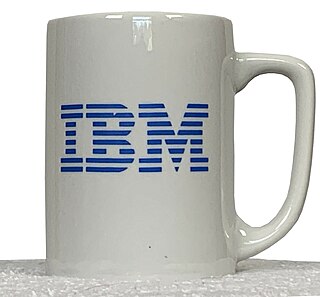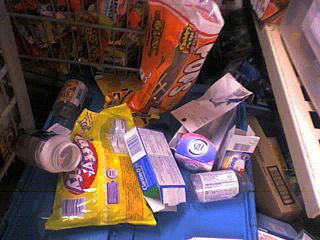Related Research Articles
In economics and finance, arbitrage is the practice of taking advantage of a difference in prices in two or more markets; striking a combination of matching deals to capitalise on the difference, the profit being the difference between the market prices at which the unit is traded. When used by academics, an arbitrage is a transaction that involves no negative cash flow at any probabilistic or temporal state and a positive cash flow in at least one state; in simple terms, it is the possibility of a risk-free profit after transaction costs. For example, an arbitrage opportunity is present when there is the possibility to instantaneously buy something for a low price and sell it for a higher price.

A cash register, sometimes called a till or automated money handling system, is a mechanical or electronic device for registering and calculating transactions at a point of sale. It is usually attached to a drawer for storing cash and other valuables. A modern cash register is usually attached to a printer that can print out receipts for record-keeping purposes.
Security management is the identification of an organization's assets, followed by the development, documentation, and implementation of policies and procedures for protecting assets.

The point of sale (POS) or point of purchase (POP) is the time and place at which a retail transaction is completed. At the point of sale, the merchant calculates the amount owed by the customer, indicates that amount, may prepare an invoice for the customer, and indicates the options for the customer to make payment. It is also the point at which a customer makes a payment to the merchant in exchange for goods or after provision of a service. After receiving payment, the merchant may issue a receipt for the transaction, which is usually printed but can also be dispensed with or sent electronically.

Shoplifting is the theft of goods from an open retail establishment, typically by concealing a store item on one's person, in pockets, under clothes or in a bag, and leaving the store without paying. With clothing, shoplifters may put on items from the store and leave the store wearing the clothes. The terms shoplifting and shoplifter are not usually defined in law. The crime of shoplifting generally falls under the legal classification of larceny. Shoplifting is distinct from burglary, robbery, or armed robbery. In the retail industry, the word shrinkage can be used to refer to merchandise lost by shoplifting, but the word also includes loss by other means, such as waste, uninsured damage to products and theft by store employees.
Sales promotion is one of the elements of the promotional mix. The primary elements in the promotional mix are advertising, personal selling, direct marketing and publicity/public relations. Sales promotion uses both media and non-media marketing communications for a pre-determined, limited time to increase consumer demand, stimulate market demand or improve product availability. Examples include contests, coupons, freebies, loss leaders, point of purchase displays, premiums, prizes, product samples, and rebates.

Pricing is the process whereby a business sets the price at which it will sell its products and services, and may be part of the business's marketing plan. In setting prices, the business will take into account the price at which it could acquire the goods, the manufacturing cost, the marketplace, competition, market condition, brand, and quality of product.
Discounts and allowances are reductions to a basic price of goods or services.

Cost of goods sold (COGS) is the carrying value of goods sold during a particular period.
Bait-and-switch is a form of fraud used in retail sales but also employed in other contexts. First, customers are "baited" by merchants' advertising products or services at a low price, but when customers visit the store, they discover that the advertised goods are not available, or the customers are pressured by salespeople to consider similar, but higher-priced items ("switching").

Merchandising is any practice which contributes to the sale of products to a retail consumer. At a retail in-store level, merchandising refers to displaying products that are for sale in a creative way that entices customers to purchase more items or products.

Retail loss prevention is a set of practices employed by retail companies to preserve profit. Profit preservation is any business activity specifically designed to reduce preventable losses. A preventable loss is any business cost caused by deliberate or inadvertent human actions, colloquially known as "shrinkage". Loss prevention is mainly found within the retail sector but also can be found within other business environments.
Inventory control or stock control can be broadly defined as "the activity of checking a shop's stock". It is the process of ensuring that the right amount of supply is available within a business. However, a more focused definition takes into account the more science-based, methodical practice of not only verifying a business's inventory but also maximising the amount of profit from the least amount of inventory investment without affecting customer satisfaction. Other facets of inventory control include forecasting future demand, supply chain management, production control, financial flexibility, purchasing data, loss prevention and turnover, and customer satisfaction.

A business can use a variety of pricing strategies when selling a product or service. To determine the most effective pricing strategy for a company, senior executives need to first identify the company's pricing position, pricing segment, pricing capability and their competitive pricing reaction strategy. Pricing strategies and tactics vary from company to company, and also differ across countries, cultures, industries and over time, with the maturing of industries and markets and changes in wider economic conditions.

Once the strategic plan is in place, retail managers turn to the more managerial aspects of planning. A retail mix is devised for the purpose of coordinating day-to-day tactical decisions. The retail marketing mix typically consists of six broad decision layers including product decisions, place decisions, promotion, price, personnel and presentation. The retail mix is loosely based on the marketing mix, but has been expanded and modified in line with the unique needs of the retail context. A number of scholars have argued for an expanded marketing, mix with the inclusion of two new Ps, namely, Personnel and Presentation since these contribute to the customer's unique retail experience and are the principal basis for retail differentiation. Yet other scholars argue that the Retail Format should be included. The modified retail marketing mix that is most commonly cited in textbooks is often called the 6 Ps of retailing.

A fuel card or fleet card is used as a payment card most commonly for gasoline, diesel, and other fuels at gas stations. Fleet cards can also be used to pay for vehicle maintenance and expenses at the discretion of the fleet owner or manager. Most fuel cards are charge cards.

In accounting, inventory shrinkage occurs when a retailer has fewer items in stock than in the inventory list due to clerical error, goods being damaged, lost, or stolen between the point of manufacture and the point of sale. This affects profit: if shrinkage is large, profits decrease. This leads retailers to increase prices to make up for losses, passing the cost of shrinkage onto customers.

Package pilferage is the theft of part of the contents of a package. It may also include theft of the contents but leaving the package, perhaps resealed with bogus contents. Small packages can be pilfered from a larger package such as a shipping container. Broader and related aspects of package theft may include taking the entire package, pallet load, truck load, shoplifting, etc. The theft may take place at any point in the parcel's journey from source to destination, including theft by rogue logistics employees and customs agents in international mail scenarios.

In finance, stock consists of all the shares by which ownership of a corporation or company is divided. A single share of the stock means fractional ownership of the corporation in proportion to the total number of shares. This typically entitles the shareholder (stockholder) to that fraction of the company's earnings, proceeds from liquidation of assets, or voting power, often dividing these up in proportion to the amount of money each stockholder has invested. Not all stock is necessarily equal, as certain classes of stock may be issued for example without voting rights, with enhanced voting rights, or with a certain priority to receive profits or liquidation proceeds before or after other classes of shareholders.
Retail leakage occurs when local people spend a larger amount of money on goods than local businesses report in sales, usually due to people traveling to a neighboring town to buy goods. Retail sales leakage occurs when there is unsatisfied demand within the trading area and that the locality should provide extra stores spaces for such type of businesses. After all, retail leakage does not necessarily translate into opportunity. For instance, there could be a tough competition in a nearby locality that leads the market for same type of product. Many small - to medium-sized communities experience leakage of retail expenditures as local citizens drive to neighboring towns to shop at national retail chains or eat at national restaurant chains. Attracting such national retail chain stores and restaurants to a community can prevent this type of expenditure leakage and create local jobs.
References
- ↑ Michael Gregg (9 May 2007). CISA Exam Prep: Certified Information Systems Auditor. Pearson Education. pp. 224–. ISBN 978-0-13-279700-9.
- ↑ Tony Pericle (2010). Transforming Data Into Action: Using Analytics for Better Distributor Sales Decisions. Natl Assn Wholesale-Distr. pp. 88–. ISBN 978-1-934014-23-3.
- 1 2 Donald J. Horan, The Retailer's Guide to Loss Prevention and Security, pp. 138-139, CRC Press, 1996 ISBN 084938110X.
- ↑ John Robert Wyman, Loss Prevention and the Small Business: The Security Professional's Guide to Asset Protection Strategies, pp. 113-114, Butterworth-Heinemann, 1999 ISBN 0750671629.